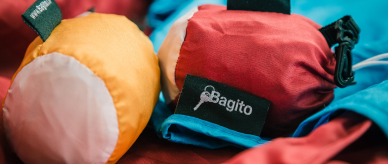Is buying second-hand really sustainable?
Here’s the thing: even though we’re opting for second-hand items over new ones, we’re still consuming at a crazy pace. It’s like we’ve created a fast-spinning merry-go-round of clothes, and we’re all caught up in the ride. Don’t get me wrong—buying second-hand is definitely better than buying new. It helps us save resources and avoid supporting unethical labor practices. But let’s be real: we’re still buying way too much. This constant cycle of buying and reselling has its own environmental impacts, like packaging and shipping.
Secondhand fashion is often celebrated as a greener choice compared to buying new clothes. With platforms like, Depop, Poshmark, and The RealReal making it simpler than ever to acquire pre-loved luxury items, it seems like a step in the right direction. However, here's the catch: even in this eco-friendly niche, overconsumption is thriving. A report from The RealReal shows that shoppers are treating secondhand fashion just like fast fashion, driven by an endless craving for the latest trends and new finds. According to Thredup, the global secondhand market is projected to grow three times faster than the overall apparel market by 2027, largely thanks to Gen Z. This trend brings up serious concerns about the true environmental impact of the resale market.
Overconsumption: A Persistent Problem
It's easy to think that buying secondhand is inherently better for the planet. After all, you're not contributing to the demand for new products, right? Well, not quite. The reality is that many people are using resale platforms to keep up with the latest trends, leading to a high churn rate and overconsumption. This is particularly true for Gen Z and millennials, who make up a significant portion of The second-hand customer base.
Second-hand becoming fast fashion
When second-hand shopping turns into a sport for some customers, and brands keep their production levels high while also benefiting from resale, it really isn’t a greener option. We’re facing a major issue with overproduction. The fact that there’s so much demand for resale shows just how high production and consumption rates are. Our focus should be on educating consumers about the true value of their purchases.
This trend isn’t just about clothes; luxury items like Cartier, Rolex, and Hermès watches, as well as Chanel and Gucci shoes, are among the most resold. The cycle of constant buying and reselling has its own environmental impact, including packaging and shipping. Some platforms, like The RealReal, are working to tackle this by using recycled materials and offsetting carbon emissions.
Even as more people understand the need for sustainable consumption, unsold goods—whether second-hand or not—still end up in landfills. The real issue isn’t that resale will become like fast fashion; it’s that fast fashion can’t be resold.
The Emotional Pull of Shopping
Why do we shop so much? It's not just about the stuff we buy; it's about how we feel when we buy it. Shopping can be an escape from the daily grind, a way to fill emotional voids, or simply a fun activity. However, this emotional shopping often leads to buying things we don't need. Most people don’t buy for logical reasons. They buy on emotion and then justify their purchases with logic. This emotional pull is particularly strong when it comes to clothes, which are tied to our identity, memories, and aspirations.
The Impact of Overconsumption
Overconsumption isn't just a problem for our wallets; it's a significant issue for the environment. The fashion industry is one of the largest polluters in the world, and while secondhand fashion can divert spending away from new products, it doesn't necessarily mean we're buying less overall. Platforms like Thredup have reported that 36% of Gen Z respondents purchase apparel weekly or monthly, the same rate at which they clear out or resell items. This constant churn undermines the sustainability goals of the resale market.
The Illusion of Sustainability
The RealReal has a Sustainability Calculator that claims to measure the environmental savings from buying secondhand. According to their calculations, users saved 3.1 billion liters of water and 59,374 metric tons of carbon dioxide last year. However, there's no industry standard for measuring these impacts, so these numbers can only be seen as indicative. Moreover, the rising prices of luxury items in the resale market make it less accessible for many people, potentially driving them back to fast fashion.
The Need for Moderation
So, what's the solution? It's clear that whether we're buying new or secondhand, moderation is key. We need to slow down our consumption, regardless of the market. Resale platforms have an opportunity to educate consumers about sustainable fashion and encourage them to buy less but better. This could include measures like limiting the number of items people can buy per year, although we're not there yet due to the sheer volume of new clothing being produced.
Rethinking the Second-Hand Market: Balancing Costs and Sustainability
Rising costs can lead to higher prices, a surprising realization for shoppers who expect bargains in the second-hand market. Sometimes, labor expenses can push the cost of second-hand clothing beyond that of new items of similar quality. For instance, a recent investigation by The Telegraph highlighted that a used Primark sweater was priced higher than a new one, calling UK thrift shopping a "right rip-off."
The resale industry’s eco-friendly image is undermined by the fact that it often relies on the sale of new clothing. For example, 80% of products on eBay, a prominent second-hand platform, are new. Similarly, Swedish resale site Sellpy's growth and technological investments have been supported by its partnership with H&M, a company that profits from selling large volumes of new fast fashion.
To make the second-hand market truly effective, we need to rethink our notions of a "good" or "healthy" economy for resale. In a growth-oriented economy, companies striving for sustainability through practices like take-back, repair, resale, and recycling are often outpriced by cheaper, non-circular competitors. The solution lies in viewing the pre-owned clothing market not only as a for-profit venture but also as an environmental necessity.
Government regulation could help, such as mandating the use of technology to reduce labor costs. For example, scannable tags could provide instant information and photos for each item, cutting down on manual sorting.
These changes could make the resale market more eco-friendly and potentially profitable, as they introduce efficiencies and support business growth through modern fulfillment centers and advanced technology.
Practical Tips to Curb Overconsumption
Understanding Your Triggers
Understanding why you shop is the first step towards curbing overconsumption. For many, shopping is a way to cope with emotions like boredom, stress, or even loneliness. It's not uncommon to turn to retail therapy as a quick fix for these feelings. However, this can lead to a cycle of buying things you don't need, which only provides temporary relief. By identifying your triggers, you can find healthier ways to cope with your emotions. For instance, if you shop when you're bored, try picking up a new hobby or spending time with friends and family. If stress drives your shopping habits, consider activities like exercise, meditation, or journaling to manage your stress levels.
Setting a Budget
Setting a budget is a practical way to control your spending. Decide on a specific amount of money you can afford to spend on clothes each month and stick to it. This not only helps you avoid impulse purchases but also makes you more mindful of your spending habits. When you have a budget, you're more likely to think twice before making a purchase. You'll start to ask yourself questions like, "Do I really need this?" or "Can I afford this right now?" This level of mindfulness can significantly reduce unnecessary spending.
Making a List
Making a list before you go shopping can be incredibly helpful. Write down the items you actually need and stick to that list. This can prevent you from getting distracted by sales or trendy items that you don't really need. A list keeps you focused and helps you avoid impulse buys. It's a simple yet effective way to ensure that you're only buying what you need.
Decluttering Your Wardrobe
Decluttering your wardrobe regularly can help you see what you already have and prevent you from buying duplicates. Go through your clothes and get rid of items you no longer wear. Donate them, sell them, or recycle them. This not only helps you create a more organized and manageable wardrobe but also makes you more aware of your shopping habits. When you see how much you already own, you're less likely to feel the need to buy more.
Shopping Mindfully
Mindful shopping is all about being intentional with your purchases. Take your time when shopping and consider whether you really need an item and how it fits into your existing wardrobe. Avoid buying things just because they're on sale or because they're trendy. Instead, focus on buying items that you truly love and that you'll wear for a long time. This approach not only helps you save money but also reduces the environmental impact of your shopping habits.
Embracing Minimalism
Embracing minimalism can be a game-changer when it comes to curbing overconsumption. Minimalism is about focusing on quality over quantity and investing in timeless pieces that you can wear for years to come. It's about creating a wardrobe that you love and that reflects your personal style, rather than constantly chasing trends. By adopting a minimalist approach to fashion, you can reduce your environmental impact and create a more sustainable wardrobe.
Striving for Balance
Ultimately, it’s about striking the right balance. While buying secondhand is generally more sustainable than purchasing new, it’s not a license to over consume. Mindful shopping is crucial, whether you're exploring a thrift store or a luxury resale site. Fashion should be enjoyable and expressive, but not at the expense of our planet or our finances. By being more deliberate in our shopping habits, we can enjoy fashion and contribute to a more sustainable future.
Reducing the overproduction of clothing is also essential. Without cutting back on the production of new garments, secondhand, upcycled, and recycled options may struggle to compete. Advocating for policies that reduce new clothing production by 40% could make a significant difference. As Kibbe points out, “We need infrastructure, we need labor, we need capital. How else are we going to solve the climate crisis?”
So, before you click "buy now," take a moment to consider whether you truly need that item or if you’re simply following a passing trend. By asking ourselves these questions, we can create a wardrobe that's both stylish and sustainable. Let's focus on progress rather than perfection—every mindful choice contributes to a better future. Happy and thoughtful shopping!














